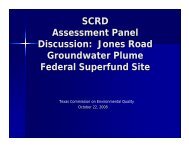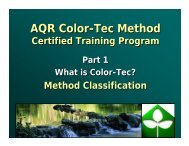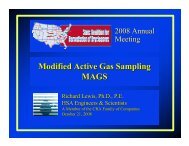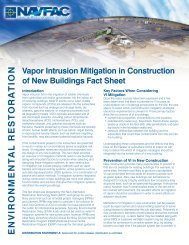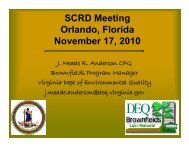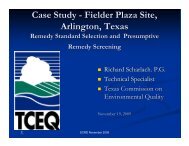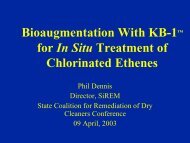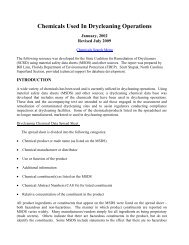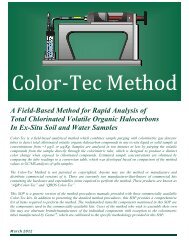Low Cost Bioremediation Using Dextrose and Recirculation to Treat ...
Low Cost Bioremediation Using Dextrose and Recirculation to Treat ...
Low Cost Bioremediation Using Dextrose and Recirculation to Treat ...
You also want an ePaper? Increase the reach of your titles
YUMPU automatically turns print PDFs into web optimized ePapers that Google loves.
Department of Environmental Quality<br />
<strong>Low</strong> <strong>Cost</strong> <strong>Bioremediation</strong> <strong>Using</strong><br />
<strong>Dextrose</strong> <strong>and</strong> <strong>Recirculation</strong> <strong>to</strong> <strong>Treat</strong><br />
PCE-Contaminated Contaminated Groundwater at<br />
Drycleaners<br />
Don Hanson<br />
Oregon Department of Environmental<br />
Quality<br />
SCRD Fall 2006 Meeting<br />
Austin, Texas
Department of Environmental Quality<br />
Oregon Program Budget Implications<br />
• More sites than we can work on with given<br />
DC Program revenue<br />
• Limits on staff availability <strong>and</strong> time <strong>to</strong> work<br />
on DC Program sites – Recent “downsizing”<br />
of Cleanup Program in Oregon<br />
• Requires prioritization based on Risk<br />
– Yearly prioritization<br />
• Focus on highest priority (Risk) <strong>and</strong> most<br />
bang for the buck (often based on access<br />
<strong>and</strong> timed with redevelopment)
Department of Environmental Quality<br />
Two Oregon Sites<br />
• NuWay II Cleaners<br />
– Lebanon, Oregon<br />
– <strong>Dextrose</strong> pilot test<br />
• Plaza Cleaners<br />
– Sweet Home, Oregon<br />
– <strong>Dextrose</strong> full Scale Implementation
Department of Environmental Quality<br />
A WORD ABOUT UNDERGROUND INJECTION<br />
CONTROL (UIC)<br />
• <strong>Recirculation</strong> process assumes<br />
underground injection can be used<br />
• Varies state <strong>to</strong> state<br />
• Oregon is UIC friendly<br />
• RCRA regulations may be a concern<br />
– On-site<br />
“treatment” – CAMU<br />
– In Oregon, Cleanup Law allows exemption of<br />
RCRA rules (on-site)
Department of Environmental Quality<br />
Biostimulation <strong>Using</strong> <strong>Dextrose</strong><br />
Why Consider <strong>Dextrose</strong><br />
– Cheap ($1.60 - $2.00/lb)<br />
– Moves with groundwater<br />
• Can flush/desorb<br />
VOCs rapidly<br />
– Quickly stimulates reducing conditions<br />
<strong>and</strong> reductive dechlorination of VOCs<br />
– Not currently proprietary
Cl<br />
Cl<br />
C=C<br />
PCE<br />
Cl<br />
Cl<br />
H<br />
Cl<br />
C=C<br />
TCE<br />
Cl<br />
Cl<br />
Ethene is rapidly utilized, no<br />
more problem!<br />
H<br />
Cl<br />
C=C<br />
cis-DCE<br />
H<br />
Cl<br />
H<br />
H<br />
C=C<br />
Ethene<br />
H<br />
H<br />
H<br />
H<br />
C=C<br />
VC<br />
H<br />
Cl
Dechlorination Process<br />
Competing electron<br />
accep<strong>to</strong>rs:<br />
Food<br />
<strong>Dextrose</strong><br />
Nutrients:<br />
N<br />
P<br />
K<br />
Trace Metals<br />
O 2<br />
Nitrate NO -<br />
3<br />
Manganese Mn 4+<br />
Ferric Fe 3+<br />
Sulfate SO 2-<br />
4<br />
Chlorinated hydrocarbons:<br />
PCE<br />
TCE<br />
DCE<br />
VC<br />
Nitrite N 2<br />
Dissolved<br />
Mn 2+<br />
Ferrous Fe 2+<br />
H 2<br />
S<br />
Ethene / Ethane
Substrate-amended H2O<br />
ISD System<br />
Nutrients<br />
<strong>Dextrose</strong><br />
ISD Concept<br />
Ground<br />
Surface<br />
Contact between e-<br />
donor <strong>and</strong><br />
chlorinated solvents<br />
Confining Layer<br />
Rapid<br />
Solvent<br />
Degradation<br />
VADOSE<br />
ZONE<br />
SATURATED<br />
ZONE<br />
Effective substrate delivery via 24/7 GW recirculation<br />
Substrate added in pulsed or continuous injection mode (pulsed is best)<br />
Highly soluble substrate, plus nutrients, <strong>to</strong> grow active biomass in porespace<br />
Max. microbial activity, ↓ ORP, methanogenic cond., ↑ dissolution
Department of Environmental Quality<br />
NuWay II Cleaners<br />
Lebanon, Oregon
Department of Environmental Quality<br />
NuWay II Cleaners Pilot Project<br />
Lebanon, Oregon<br />
• Former Cleaners – Now Retail<br />
• Operated from 1953 <strong>to</strong> 1976<br />
• S<strong>to</strong>ddard <strong>and</strong> PCE Used <strong>and</strong> spilled<br />
• Beneficial Use Aquifer<br />
• P&T From 1998 <strong>to</strong> 2003<br />
– <strong>Treat</strong>ed groundwater VOCs w/ Air stripping<br />
– POTW Discharge<br />
– Mass removal <strong>and</strong> hydraulic containment<br />
• Increasing O&M (Aging System)<br />
• Decreasing mass removal<br />
• Failed attempt at aerobic cometabilisim pilot in 2004
Department of Environmental Quality<br />
NuWay Pilot Study Objectives<br />
<br />
<br />
<br />
<br />
<br />
Use existing “pump <strong>and</strong> treat” infrastructure for anaerobic<br />
recirculation system<br />
Two injection wells (direct push – prepack screens)<br />
Transfer O&M costs (P&T/Air Stripping) <strong>to</strong> destruction of<br />
contaminants in GW <strong>and</strong> soil matrix<br />
Evaluate effectiveness of low (
Department of Environmental Quality<br />
Pilot Study Plan View – NuWay II Cleaners
Department of Environmental Quality<br />
NuWay II – Existing Remediation Enclosure
<strong>Recirculation</strong> System<br />
1.0 GPM<br />
<strong>Dextrose</strong> <strong>and</strong><br />
Nutrients added<br />
(continuous)<br />
P-1<br />
MW-3<br />
MW-2<br />
MW-15<br />
IN-1&2<br />
SILT<br />
silty-s<strong>and</strong>y s<strong>and</strong>y GRAVEL<br />
silty CLAY (aquitard)
Department of Environmental Quality<br />
NuWay Pre-Pilot Pilot VOC Concentrations
Theoretical Calculate Carbohydrate Dem<strong>and</strong> – NuWay II Cleaners<br />
Compound<br />
(Electron Accep<strong>to</strong>r)<br />
Chlorinated Ethenes<br />
Tetrachloroethene<br />
Chemical<br />
Formula<br />
C 2 Cl 4<br />
S<strong>to</strong>ichiometry<br />
Compound<br />
Concentration<br />
(mg/L)<br />
C 2 Cl 4 + 8e - + 4H + --> C 2 H 4 + 4Cl - 0.4<br />
Carbohydrate<br />
Dem<strong>and</strong><br />
(mg/L)<br />
0.14<br />
Trichloroethene<br />
C 2 HCl 3<br />
C 2 HCl 3 + 6e - + 3H + --> C 2 H 4 + 3Cl -<br />
0.1<br />
0.03<br />
Dichloroethene<br />
C 2 H 2 Cl 2<br />
C 2 H 2 Cl 2 + 4e - + 2H + --> C 2 H 4 + 2Cl -<br />
0.1<br />
0.03<br />
Vinyl Chloride<br />
C 2 H 3 Cl<br />
C 2 H 3 Cl + 2e - + H + --> C 2 H 4 + Cl -<br />
0.05<br />
0.01<br />
Competing Electron Accep<strong>to</strong>rs<br />
Oxygen<br />
O 2<br />
O 2 + 4H + + 4e - --> 2H 2 O<br />
4<br />
3.75<br />
Nitrate<br />
NO 3<br />
-<br />
2NO 3 - + 12H + + 10e - --> N 2 + 6H 2 0<br />
4<br />
0.48<br />
Sulfate<br />
SO 4<br />
2-<br />
SO 4<br />
2-<br />
+ 10H + + 8e - --> H 2 S + 4H 2 0<br />
20<br />
12.51<br />
Inorganic Solids<br />
Iron<br />
Fe 3+<br />
FeOOH + e - + 3H + --> Fe 2+ + 2H 2 O<br />
10<br />
0.85<br />
Manganese<br />
Mn 4+<br />
MnO 2 + 2e - + 4H + --> Mn 2+ + 2H 2 O<br />
10<br />
1.73<br />
Total S<strong>to</strong>ichiometric Carbohydrate Dem<strong>and</strong> 19.53
Department of Environmental Quality<br />
Actual Carbohydrate (dextrose) Added<br />
• Theoretical calculations indicated only 30 lbs.<br />
dextrose would be needed (did not pass the laugh<br />
test)<br />
• Increased dextrose concentration until TOC values<br />
were over 100 mg/L<br />
• 2 Pore volumes, 800 lbs dextrose, equals about 480<br />
mg/L dextrose<br />
• Highest TOC value we saw was 200 mg/L (about 10x<br />
theoretical needed)<br />
• <strong>Dextrose</strong> metered in mostly contintinuously
Moni<strong>to</strong>ring <strong>and</strong> Troubleshooting – NuWay Cleaners<br />
Complete dechlorination:<br />
PCE, TCE, DCE, VC <strong>and</strong> ethene<br />
Adequate food source:<br />
TOC analysis, increased feed rate<br />
Field parameters within range:<br />
pH, ORP, DO<br />
Competing electron recep<strong>to</strong>rs:<br />
DO, NO 3 - , Mn 4+ , Fe 3+ <strong>and</strong> SO 2-<br />
4<br />
Excessive hydrogen production:<br />
Methane<br />
Healthy microbial population:<br />
Total heterotrophic bacteria<br />
Limiting nutrient for microbes:<br />
NH 3<br />
<strong>and</strong> P<br />
Parameter Baseline 5 Months<br />
Chlorinated Solvents<br />
PCE <strong>and</strong> TCE >100 ug/L
MW-15s<br />
– NuWay II Cleaners<br />
PCE, TCE, VC, ethene/ethane Concentrations (ppb) (<br />
70<br />
60<br />
50<br />
40<br />
30<br />
20<br />
10<br />
0<br />
0<br />
60<br />
MW-15S Groundwater Concentrations<br />
120<br />
180<br />
240<br />
DAYS<br />
300<br />
360<br />
PCE<br />
TCE<br />
VC<br />
Ethene/ethane<br />
cis-DCE<br />
420<br />
180<br />
160<br />
140<br />
120<br />
100<br />
80<br />
60<br />
40<br />
20<br />
0<br />
cis-DCE Concentration (<br />
OBSERVATIONS:<br />
• Day 150 system<br />
shut down<br />
• PCE/TCE reduced<br />
within 30 days<br />
• Cis-DCE stable up<br />
<strong>to</strong> Day 60, then<br />
decreased<br />
• VC increased from<br />
Day 30 <strong>to</strong> 120,<br />
then rapidly<br />
decreased<br />
• Ethene/ethane<br />
production<br />
correlates with VC<br />
generation <strong>and</strong><br />
transformation<br />
• No PCE/TCE<br />
rebound observed
PCE, TCE, VC, ethene/ethane Conc.<br />
40<br />
35<br />
30<br />
25<br />
20<br />
15<br />
10<br />
5<br />
0<br />
0<br />
60<br />
120<br />
MW-2S Groundwater Concentrations<br />
180<br />
240<br />
DAYS<br />
300<br />
360<br />
TCE<br />
VC<br />
Ethene/ethane<br />
PCE<br />
cis-DCE<br />
420<br />
200<br />
180<br />
160<br />
140<br />
120<br />
100<br />
80<br />
60<br />
40<br />
20<br />
0<br />
cis-DCE Concentrations (ppb)<br />
OBSERVATIONS:<br />
• PCE/TCE reduced<br />
within 65 days<br />
• Cis-DCE stable up<br />
<strong>to</strong> Day 90, then<br />
decreased<br />
• VC increased from<br />
Day 30 <strong>to</strong> 120, then<br />
decreased<br />
• Ethene/ethane<br />
production<br />
correlates with VC<br />
• No PCE/TCE<br />
rebound observed,<br />
but cis-DCE<br />
showing rebound<br />
possibly due <strong>to</strong><br />
LNAPL (S<strong>to</strong>ddard)<br />
at this location
MW-3S Groundwater Concentrations<br />
OBSERVATIONS:<br />
PCE, TCE, VC, ethene/ethane Concentrations (ppb)<br />
600<br />
500<br />
400<br />
300<br />
200<br />
100<br />
System<br />
Startup<br />
C<br />
PCE<br />
TCE<br />
VC<br />
Ethene/ethane<br />
cis-DCE<br />
1200<br />
1000<br />
800<br />
600<br />
400<br />
200<br />
cis-DCE Concentrations (ppb)<br />
• PCE/TCE<br />
reduced below<br />
detection limits<br />
•Cis-DCE, VC,<br />
Ethene/ethane<br />
concentrations<br />
correlate<br />
•No PCE/TCE<br />
rebound observed<br />
•Continuing<br />
Activity 10 months<br />
after shutdown,<br />
likely due <strong>to</strong><br />
biomass<br />
degradation<br />
0<br />
0<br />
60<br />
120<br />
180<br />
240<br />
300<br />
360<br />
420<br />
0<br />
•Need additional<br />
injection point <strong>to</strong><br />
better contact this<br />
location (not in<br />
primary flow path)
Department of Environmental Quality<br />
Pilot-scale Comments<br />
NuWay II Cleaners<br />
• Approach was effective with 1 gpm flow rate, <strong>and</strong> with using 1 extraction<br />
well <strong>and</strong> 2 pre-packed<br />
packed Geoprobe points spaced 15 ft apart<br />
• Pilot test affected saturated zone far beyond the demonstration area<br />
• Has continued <strong>to</strong> treat chlorinated solvents 11 months after recirculation<br />
rculation<br />
ceased<br />
• LNAPL recovery needs <strong>to</strong> be conducted at MW-2S <strong>to</strong> remove S<strong>to</strong>ddard<br />
solvent<br />
• Need at least one additional extraction well, <strong>and</strong> two more injection points<br />
for full scale treatment<br />
• Do not expect a rebound in the MW-15S or MW-2S area, but rebound<br />
around MW-3 3 likely since it wasn’t t directly in the recirculation flow path<br />
• Continuous electron donor delivery tended <strong>to</strong> cause fouling at<br />
injection points – pulsed delivery preferred <strong>to</strong> clear injection points
Department of Environmental Quality<br />
Plaza Cleaners<br />
Sweet Home, Oregon
Department of Environmental Quality<br />
Plaza Cleaners - Background<br />
• Active Cleaners 1971 <strong>to</strong> 2001<br />
• Small “strip” shopping center<br />
• PCE was primary solvent used<br />
• No “known” releases<br />
• Buildings demolished in 2001<br />
• 2001 initial investigation found PCE in soil <strong>and</strong><br />
groundwater<br />
• Site currently level <strong>and</strong> planned for<br />
redevelopment<br />
• Beneficial groundwater use in the area – no<br />
private wells currently impacted
Department of Environmental Quality<br />
Plaza Cleaners – Sweet Home
Department of Environmental Quality<br />
DEQ Objectives at Plaza Cleaners<br />
• Take advantage of vacant “flat lot” site<br />
• Room <strong>and</strong> time for focused soil <strong>and</strong><br />
groundwater assessment <strong>and</strong> treatment<br />
• Avoid indoor air problems in planned new<br />
building!
Department of Environmental Quality<br />
Plaza Cleaners Removal Assessment<br />
Oc<strong>to</strong>ber 2005 - SOIL<br />
• Mobile Lab<br />
• Geoprobe<br />
• 2 days<br />
• Soil <strong>and</strong><br />
groundwater<br />
collected<br />
• No Moni<strong>to</strong>ring<br />
wells
Department of Environmental Quality<br />
Plaza Cleaners Removal Assessment<br />
Oc<strong>to</strong>ber 2005 – GROUNDWATER
Department of Environmental Quality<br />
Plaza Cleaners Removal July 2006<br />
• Source soil<br />
excavation <strong>to</strong><br />
water table<br />
• Install<br />
infrastructure for<br />
recirculation<br />
groundwater<br />
treatment
Department of Environmental Quality<br />
Plaza Cleaners Removal – July 2006<br />
• Soil treated on-site<br />
w/ SVE Ex-Situ<br />
• Currently in-<br />
progress<br />
• Est. 6 months max<br />
• Samples in Oc<strong>to</strong>ber<br />
showed treatment<br />
nearly complete<br />
• Delist soil using<br />
Contained In Rule<br />
• Plan <strong>to</strong> re-use soil<br />
on-site
Department of Environmental Quality<br />
Full Scale Groundwater Remediation<br />
Plaza Cleaners – Sweet Home, Oregon<br />
Begun August 2006<br />
• Full-scale ongoing (Started August 2006) <strong>to</strong> remediate<br />
source area using 6”-dia. 6<br />
Injection well, <strong>and</strong> 6”-dia. 6<br />
Extraction well<br />
• Inject in piping installed in excavation<br />
• High DO, high groundwater velocity<br />
• All PCE, no co-mingled hydrocarbons<br />
• Recirculating ISD system using dextrose <strong>and</strong> nutrients<br />
• 6 month estimated timeframe <strong>to</strong> reduce CAHs by 80%
IN-1
Department of Environmental Quality<br />
Groundwater <strong>Treat</strong>ment Regime<br />
Plaza Cleaners<br />
• <strong>Treat</strong>ment Area (200’ x 100’ x 25’ sat. thickness)<br />
• Operated at 2 gpm<br />
• Est. 4,000 lbs dextrose <strong>to</strong> be added<br />
– 50 lbs diammonium phosphate/100 lbs dextrose<br />
– 3 lbs yeast extract/100 lbs dextrose<br />
• <strong>Dextrose</strong>/nutrients added in batches weekly<br />
• Groundwater pumping <strong>and</strong> recirculation is<br />
continuous<br />
– Flushes well screen between batches <strong>and</strong> avoids fouling
Department of Environmental Quality<br />
Estimating <strong>Dextrose</strong>/Nutrient Dem<strong>and</strong><br />
Plaza Cleaners – Sweet Home<br />
• Estimate pore volume based on treatment zone<br />
dimensions (200’x100<br />
x100’x25’)<br />
• Calculate dem<strong>and</strong> by electron accep<strong>to</strong>rs (PCE [5 mg/L],<br />
DO 7 mg/L, Nitrate 3mg/L, etc.)<br />
• Calculate electron donor needed <strong>to</strong> overcome electron<br />
accep<strong>to</strong>rs <strong>and</strong> multiply by fac<strong>to</strong>r of 10<br />
• At Plaza, this equated <strong>to</strong> 4,800 lbs. Backed off <strong>to</strong> 4,000<br />
initial estimate<br />
• Past experience at NuWay of using straight<br />
s<strong>to</strong>ichometric ratio 1:1 was not enough<br />
• Adjust dextrose loading based on TOC analysis<br />
(emperical<br />
rather than theoretical approach)
MW-1 1 ( Midpoint)<br />
Date<br />
PCE (ppb)<br />
TCE (ppb)<br />
cis-DCE<br />
(ppb)<br />
VC<br />
(ppb)<br />
Ethene/ethane (ppb)<br />
8/11/06<br />
Baseline<br />
3,000<br />
170<br />
38<br />
Department of Environmental Quality<br />
MW-1 VOCs
Extraction well EX-1<br />
Date<br />
PCE (ppb)<br />
TCE (ppb)<br />
cis-DCE<br />
(ppb)<br />
VC<br />
(ppb)<br />
Ethene/ethane (ppb)<br />
8/11/06<br />
Baseline<br />
2,700<br />
76<br />
86<br />
Department of Environmental Quality<br />
Plaza Cleaners Groundwater Parameters
Department of Environmental Quality<br />
What Next<br />
Plaza Cleaners<br />
• 4 More months of recirculation treatment planned<br />
• Moni<strong>to</strong>r transformation of CIS-DCE <strong>to</strong><br />
ethene/ethane<br />
– Watch for cis “stall”<br />
– Watch for VC formation (should drop off rapidly)<br />
– Cis may go directly <strong>to</strong> ethene/ethane<br />
• Watch for PCE/TCE rebound/desorption<br />
desorption<br />
• Bioaugment Hopefully not. Dechlorination is<br />
occurring
Department of Environmental Quality<br />
<strong>Cost</strong> Estimate<br />
Plaza Cleaners Groundwater<br />
• Injection <strong>and</strong> Extraction Wells (sonic)<br />
– $14,000 (incl. Hart Crowser oversight)<br />
• Infiltration Piping<br />
– $10,000<br />
• Electron Donor (<strong>Dextrose</strong> blend) <strong>and</strong> ETEC O&M<br />
for 6 months<br />
– $18,000<br />
• Hart Crowser Oversight <strong>and</strong> Moni<strong>to</strong>ring (6 months)<br />
<strong>and</strong> Reporting<br />
– $34,000<br />
• TOTAL EST. COST $76,000
Department of Environmental Quality<br />
<strong>Dextrose</strong> Groundwater <strong>Recirculation</strong><br />
Lessons Learned<br />
• Easy <strong>to</strong> implement;<br />
• <strong>Cost</strong> effective products;<br />
• Improved success with re-circulation (extraction,<br />
amending, re-injection) over gravity feed/slug injections.<br />
• Can mobilize (<strong>and</strong> treat) sorbed NAPL/source<br />
contaminants<br />
• Limited <strong>to</strong> relatively permeable aquifer materials <strong>and</strong><br />
shallow aquifers;<br />
• Can destroy a lot of PCE quickly<br />
• Should reduce CIS/VC based on pilot results at NuWay<br />
Cleaners
Department of Environmental Quality<br />
Questions





